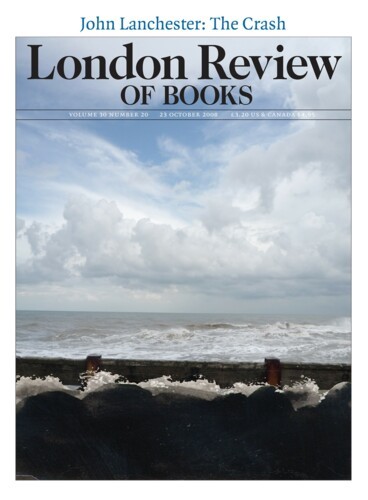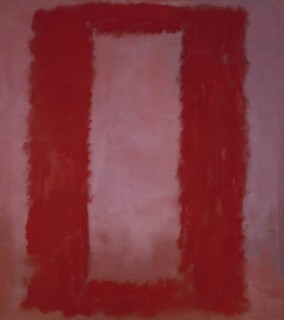In the second, narrow room of the Tate Modern exhibition Rothko: The Late Series a single canvas fills most of one of the long walls. Rothko, who wanted people to have the experience of being enveloped by his pictures, would have been happy with the way the constricted space pushes viewers towards the empty facing wall. It is as if the picture was a radiator the heat of which drives you back. You must wait for your turn in the line because people linger. Some pictures are read quickly: Rothko’s are best taken slowly. Yet even if we all say the same things about the exhilaration and the pleasure we feel when reading black on purple-black or red on red on red, finding the depths in the pictures suggested by some of Rothko’s statements is now, and probably always was, an act of faith that requires a sort of self-hypnosis.
The series that dominates the exhibition, the Seagram murals, arose from a commission for paintings to line the walls of a private dining-room in the Four Seasons restaurant in Mies van der Rohe’s Seagram Building on Park Avenue. In the fifth and seventh sections – both long letterbox shapes, both red on maroon – the fuzzy rectangles that are the central motif in all the canvases have risen towards the top, like bubbles in a thick liquid. The fuzziness, the darkness, the redness, the unevenness of the margins, make the pictures active and unresolved. The effect is romantic, quite unlike the reposeful geometry of abstract pictures in which something like the solution of an equation takes place. But there are limits to what even active, unresolved abstraction can communicate. From Rothko’s point of view it is a defeat if his pictures have come to be merely beautiful – not tragic, not poignant, just blissfully absorbing. On the first page of the catalogue a remark of his is set in large type: ‘If people want sacred experiences they will find them here. If they want profane experiences they’ll find them too. I take no sides.’ But he does, because to say that there are sacred and profane readings implies that his art will do more than finally float down to a level that may be solemn, but is essentially, and merely, aesthetic.
At the Rothko Chapel in Houston, and in the rooms in which the Seagram murals have been displayed in the Tate, people gather and sit quietly. But when you stop thinking, and start looking, you’re left with responses that are amenable to analysis only in terms of the way shapes and colours work on eye and mind. Not that that is a small thing. In inventing and developing a vocabulary Rothko expanded the expressive potential of abstract painting. He was unhappy with the idea that people might see nothing in his art but wonderfully pleasing colour; the maroon gloom of the Seagram murals was, in part at least, a move away from that; he even said that the aim was to ruin the appetite of the rich diners who would sit with them. But in the end he activated a get-out clause in his contract. His work wasn’t to be a backdrop for expensive eating.
The Tate exhibition – on view until 1 February next year – brings together late work. It puts the Seagram murals, studies for them and alternative versions of them, alongside later series in which soft-edged forms are abandoned. One group is of very dark, mainly black paintings in which rectangles sit on backgrounds almost as dark. In two other series the picture surface is divided horizontally into upper, darker areas of black or brown and lower, paler ones of grey or brown. In both the painted area is surrounded by a narrow white border. Differences between pictures that are structurally very similar and black, near-black or muddy greys and browns, allowed Rothko, and have allowed others since, to offer commentaries which, like jazz versions of simple songs, are interpretations that must be sustained by their inherent interest. These pictures don’t offer even the solemn pleasures of the near-black canvases; without commentary they are stern and unwelcoming.
The light in the exhibition is quite dim – that is what Rothko preferred. In his instructions for the way his work should be shown at the 1961 Whitechapel exhibition he wrote: ‘The light, whether natural or artificial, should not be too strong: the pictures have their own inner light and if there is too much light, the colour in the picture is washed out and a distortion of their look occurs.’ He talks about matching the light of the ‘normally lit room’ in which they were painted. One reason for low light levels may be curatorial. Rothko’s materials were various and have not always lasted well. In the catalogue a table sets out the materials and processes used in the Seagram murals to achieve a richness in which glazes, underpainting, overpainting, and the contrast between matt and gloss surfaces all have a part to play. In it there are columns for earth, clay and egg as well as for various pigments, natural and synthetic, oils, resins and so forth. But the Seagram pictures seem to be relatively stable, unlike, say, the Harvard murals of 1961-62 that faded so rapidly that they had to be removed from view.
The circumstances of abstract painting in New York in the 1950s come to us through memoirs and photographs. The city was changing. Here and there the stone fronts of interwar skyscrapers were reflected in the glass walls of new buildings that realised prewar European dreams. The old symbols of modernity were being replaced by things that were swifter, shinier and more transparent. Meanwhile, new kinds of picture – big, abstract and painterly – were being produced in warehouse spaces belonging to that heavier 19th-century modernity. The studios were, to judge by photographs of Rothko’s own work spaces, high, dim and unkempt. It is hard to believe that these paintings ever looked as good as they did when still in the places where they were made. It is also easy to see why Rothko’s patrons in Houston and New York saw his potential as a maker of environments. But the rooms he was inspired by, spaces like Michelangelo’s vestibule to the Laurentian Library in Florence, were quite unlike the light-filled ones in the Seagram Building. A 20th-century space with a Michelangelesque or Pompeian presence wasn’t achieved – not even, judging by photographs, in the Houston chapel – but the Seagram murals have a grandeur that shows why, in New York in the middle of the 20th century, an art as ambitious in scale and intentions as those history offered, did briefly seem to have arrived.
Send Letters To:
The Editor
London Review of Books,
28 Little Russell Street
London, WC1A 2HN
letters@lrb.co.uk
Please include name, address, and a telephone number.


